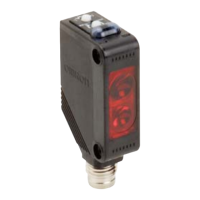Photoelectric Sensors Technical Guide
General Precautions
For precautions on individual products, refer to Safety Precautions in individual product information.
These Sensors cannot be used in safety devices for
presses or other safety devices used to protect
human life. These Sensors are designed for use in
applications for sensing workpieces and workers
that do not affect safety.
To ensure safety, always observe the following precautions.
● Wiring
● Operating Environment
(1) Do not use a Sensor in an environment where there are explosive or inflammable gases.
(2) Do not use the Sensor in environments where the cables may become immersed in oil or other liquids or where liquids may penetrate the
Sensor. Doing so may result in damage from burning and fire, particularly if the liquid is flammable.
WARNING
Precautions for Safe Use
Item Typical examples
Power Supply Voltage
Do not use a voltage in
excess of the operating
voltage range.
Applying a voltage in excess
of the operating voltage
range, or applying AC power
(100 VAC or greater) to a DC
Sensor may cause explosion
or burning.
---
Load Short-circuiting
Do not short-circuit the load.
Doing so may cause explo-
sion or burning.
Incorrect Wiring
Do not reverse the power
supply polarity or otherwise
wire incorrectly. Doing so
may cause explosion or
burning.
Connection without a
load
If the power supply is
connected directly without a
load, the internal elements
may burst or burn. Be sure to
insert a load when
connecting the power
supply.
Load
Sensor
Brown
Blue
Black
• DC Three-wire NPN Output Sensors
+
-
(Load
short
circuit)
Load
Sensor
Brown
Blue
Black
• DC Three-wire NPN Output Sensor
(Load short circuit)
Load
Sensor
Brown
Blue
• AC Two-wire Sensors
Example: E3E2
-
+
Load
Sensor
Brown
Blue
Black
• DC Three-wire NPN Output Sensors
Example: Incorrect Polarity

